Keeping Time with the Skies Chapter Notes | Chapter Notes For Class 8 PDF Download
Have you ever noticed the Moon shining in the sky during the daytime and wondered why it’s visible when the Sun is also up?
On Makar Sankranti, as Meera watched colorful kites soar above Ahmedabad, she too spotted the Moon in broad daylight—a sight she thought belonged only to the night. 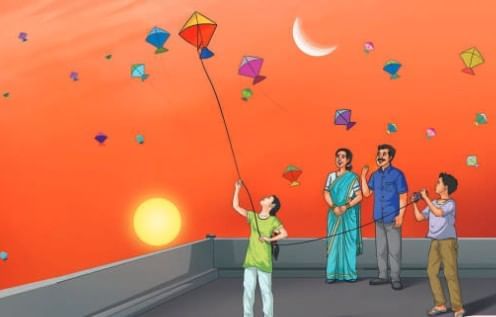 Kites in the SkyThis surprising view made her curious: Why does the Moon’s shape change night after night, and why doesn’t it always appear as a full circle? If we had no clocks or calendars, how would we track days, months, or years? As we explore these questions, let’s discover how people have “kept time” by simply observing the skies!
Kites in the SkyThis surprising view made her curious: Why does the Moon’s shape change night after night, and why doesn’t it always appear as a full circle? If we had no clocks or calendars, how would we track days, months, or years? As we explore these questions, let’s discover how people have “kept time” by simply observing the skies!
How Does the Moon’s Appearance Change and Why?
Phases of the Moon
The changing shapes of the Moon’s illuminated (bright) portion, as seen from Earth, are known as the phases of the Moon.
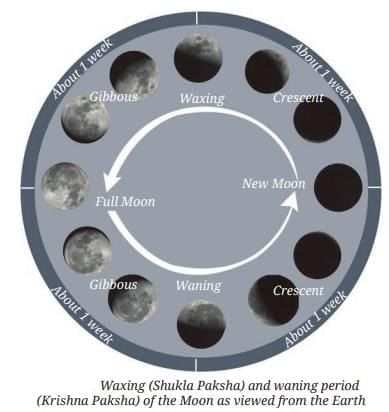
Waning Period (Krishna Paksha):
- After a full Moon, the bright portion decreases from a full circle to a half circle in about a week.
- The bright portion continues to shrink, disappearing completely in another week.
- This two-week shrinking period is called the waning period or Krishna Paksha in India.
New Moon (Amavasya): The day when the Moon is not visible at all.
Waxing Period (Shukla Paksha):
- After the new Moon, the bright side grows to a half circle in about a week and becomes a full circle (full Moon) in another week.
- This two-week growing period is called the waxing period or Shukla Paksha in India.
- The Moon’s waxing and waning occurs in a cyclical (repeating) pattern each month.
- The full cycle from one full Moon to the next takes about one month.
Important Terms:
- Full Moon (Purnima): The day when the Moon appears as a full bright circle.
- New Moon (Amavasya): The day when the Moon is not visible at all.
- Waxing: The period when the bright part of the Moon increases (after new Moon to full Moon).
- Waning: The period when the bright part of the Moon decreases (after full Moon to new Moon).
- Gibbous: More than half but not fully illuminated Moon.
- Crescent: Less than half illuminated Moon.
Locating the Moon
The Moon’s position in the sky changes each day, even at the same time.
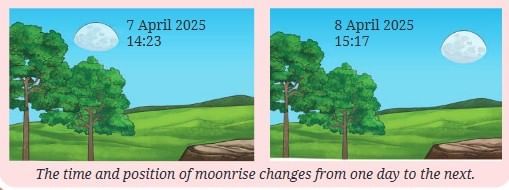
On full Moon day:
- The Moon is nearly opposite the Sun.
- When the Sun rises in the east, the Moon is almost setting in the west.
After full Moon:
- Each morning at sunrise, the bright part of the Moon gets smaller and the Moon appears closer to the Sun’s position in the sky.
- When the Moon looks like a half circle, it is overhead at sunrise.
- A few days after, the crescent Moon appears even closer to the Sun.
The phase (shape) of the Moon and its waxing or waning status help you know where and when to look for it in the sky.
- Waxing Moon: Best seen at sunset.
- Waning Moon: Best seen at sunrise.
The Moon does not always rise when the Sun sets.
- The moonrise time gets about 50 minutes later each day.
- Moonrise can occur in the afternoon (e.g., between 2:00–4:00p.m.), which is why the Moon is sometimes seen in the daylight.
- After moonrise, you may need to wait about 30 minutes for the Moon to be visible higher in the sky.
Making Sense of Our Observations – The Moon’s Changing Appearance
The Moon’s Shape:
The actual shape of the Moon does not change at all. What changes is how much of the illuminated (bright) part we see from Earth.
The Moon’s Light:
The Moon does not produce its own light. It appears bright because it reflects sunlight that falls on it.
Sunlit and Dark Halves:
- At any moment, half of the Moon faces the Sun and becomes illuminated by sunlight.
- The other half, facing away from the Sun, remains in darkness (non-illuminated).
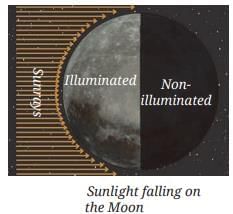
Appearance from Earth:
- As the Moon revolves around the Earth, the position and angle at which we see it changes.
- Although always one half of the Moon faces Earth, that half is not always fully illuminated.
- The portion of the Moon we see from Earth may be all illuminated, partly illuminated, or not illuminated at all—resulting in phases.
Full Moon and New Moon:
- Full Moon: When the entire sunlit half faces Earth, we see the Moon as a whole bright circle.
- New Moon: When the non-illuminated half faces Earth, we do not see the Moon at all.
Reason for Changing Appearance:
The Moon seems to change shape (phase) on different days because:
- Its position relative to Earth and Sun is constantly changing as it orbits Earth.
- We only see the illuminated part facing towards us.
The Moon’s Phases with a Simple Model
Model Demonstration:
You can use a small ball on a stick to represent the Moon, a torch or lamp as the Sun, and your own head as the Earth.
- Hold the ball in your hand, slightly above your head.
- Shine the torch toward the ball to represent sunlight.
- As you turn in a circle, the ball (“Moon”) shows a changing illuminated portion to your eyes.
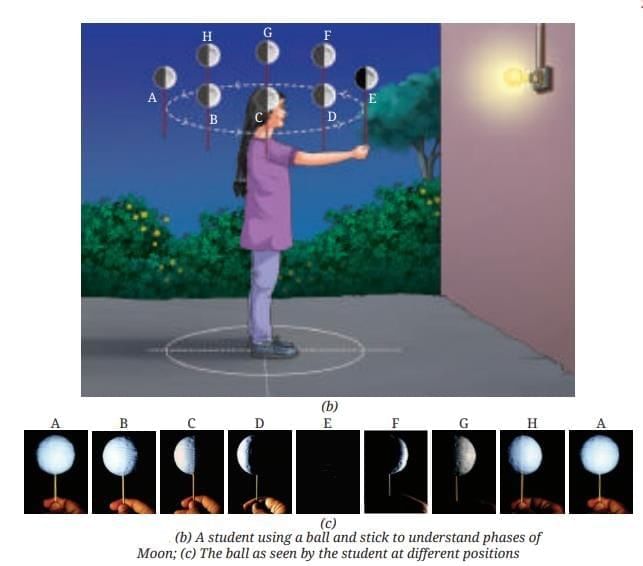
What Does the Model Show?
- Full Moon:
When the ball is held opposite the lamp (behind you compared to the Sun), the side facing you is fully lit—just like a full Moon. - New Moon:
When the ball is held between your head and the lamp (towards the Sun), you see only the dark side—like a new Moon. - Crescent and Gibbous Phases:
Turning the ball slowly, the visible portion transitions. Sometimes you see a crescent (less than half lit), other times gibbous (more than half lit). - The line between the bright and dark parts is always curved—this matches what we see in the real Moon.
The Science Behind the Phases
- Half Illuminated, Half Dark:
At every moment, half the Moon is lit by sunlight, and half is in darkness. - Moon’s Revolution:
As the Moon revolves around the Earth, the angle between Earth, Moon, and Sun changes. The part of the Moon we see as bright changes accordingly.
Phase Names:
- Crescent: Less than half illuminated
- Gibbous: More than half illuminated
- Full Moon: Whole face illuminated
- New Moon: No illuminated part visible
The phases are caused by the changing fraction of the illuminated portion visible from Earth.
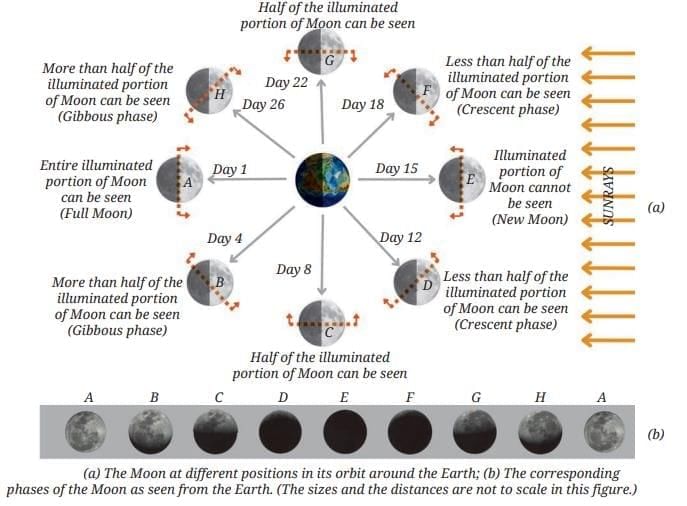
Why Do Moon Phases Occur? (And What Does Not Cause Them)
- Incorrect Idea: Moon phases are not caused by Earth’s shadow falling on the Moon.
Correct Reason: The phases of the Moon occur because of the changing relative positions (orientation) of the Sun, Moon, and Earth as the Moon revolves around Earth.
Earth’s Shadow and Lunar Eclipse: The only time Earth’s shadow actually falls on the Moon is during a lunar eclipse.
Lunar eclipses can only happen on a full Moon day.
Solar eclipses can only happen on a new Moon day.
Why Don’t Eclipses Happen Every Month?
- Eclipses do not occur every month even though there’s a full Moon and new Moon monthly.
- This is because the Moon’s orbit is slightly tilted relative to Earth’s orbit around the Sun.
- Most months, the Sun, Earth, and Moon do not line up perfectly for the Earth’s shadow to cover the Moon (lunar eclipse) or for the Moon’s shadow to fall on Earth (solar eclipse).
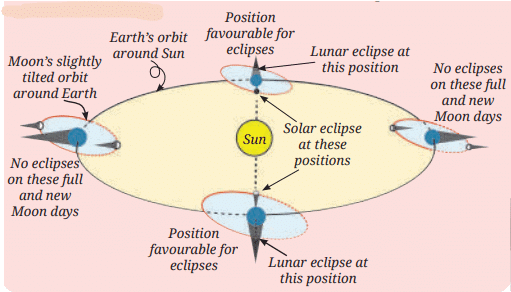
How Did Calendars Come into Existence?
Natural Cycles and Time Measurement
- The apparent daily motion of the Sun (rising in the east, setting in the west) is due to Earth’s rotation on its axis.
- This natural cycle forms the basis of the day—the primary unit of timekeeping.
- Mean Solar Day: The time between one “highest Sun position” (shortest shadow at noon) to the next is about 24 hours, known as a mean solar day.
Shadow Tracking and the Day
- The shortest shadow during the day marks the Sun’s highest point in the sky (noon).
- Measuring from one day’s noon to the next gives the length of a day.
- The average solar day is about 24 hours.
The Month and the Moon
- The phases of the Moon create another natural cycle—one complete phase cycle (from full Moon to next full Moon) takes about 29.5 days (approximately one month).
- This lunar cycle is the basis for measuring a month.
The Year and the Seasons
- One year is the duration for Earth to make a full revolution around the Sun, which is about 365¼ days.
- The repetition of seasons (spring, summer, autumn, winter) marks the annual cycle.
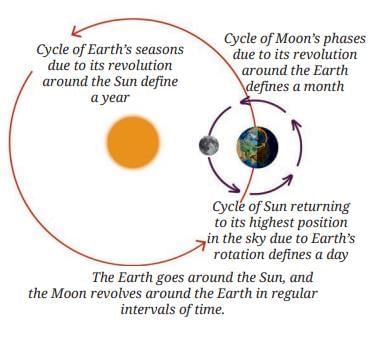
Types of Calendars
1. Lunar Calendars
- Based on the phases of the Moon.
- Each lunar month is about 29.5 days and 12 lunar months make a year of about 354 days.
- This lunar year is shorter than a solar year, so the months shift with respect to the seasons over time.
2. Solar Calendars
- Based on Earth’s revolution around the Sun and the arrival of seasons.
- The Gregorian calendar is a solar calendar (used worldwide), with months adjusted so the year has 365 days.
- To correct the extra ¼ day, a leap day is added every 4 years (February 29).
- Leap year rule: Years divisible by 4 are leap years, with additional adjustments (skip leap years every 100 years, but add them back every 400 years).
3. Luni-Solar Calendars
- Combine lunar months with corrections to keep in sync with the solar year and seasons.
- In India and elsewhere, every 2–3 years, an extra month (Adhika Maasa) is added to adjust the calendar with the solar year.
- The names of months in Indian luni-solar calendars include: Chaitra, Vaisakha, Jyeshtha, Ashadha, Shravana, Bhadrapada, Ashwin, Kartika, Margashirsha (Agrahayan), Pausha, Magha, and Phalguna.
- Amant Calendars: Month begins after a new Moon and ends on the next new Moon.
- Purnimant Calendars: Month begins after a full Moon and ends at the next full Moon.
Observations and Heritage
- Ancient observers noticed 12 cycles of Moon phases fit in one yearly cycle of seasons.
- The Sun’s position at sunrise changes through the year (northward in summer, southward in winter) due to Earth’s tilt.
- This movement is described in Indian tradition as Uttarayana (northward, Dec–June) and Dakshinayana (southward, June–Dec).
- Solstices and equinoxes: Important points for tracking the Sun’s yearly journey and adjusting calendars.
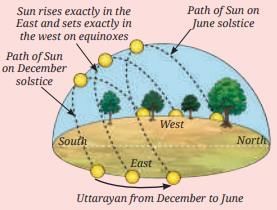
The Indian National Calendar
The Indian National Calendar, also known as the Saka Calendar, is a solar calendar officially used by the Government of India along with the Gregorian calendar.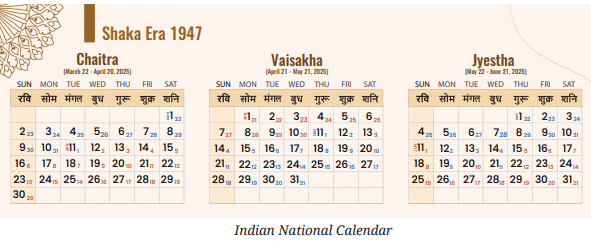
- It consists of 365 days in a year.
- The year begins on 22 March (the day after the spring equinox). In leap years, it begins on 21 March.
- Each month is named after traditional Indian months: Chaitra, Vaisakha, Jyestha, Ashadha, Shravana, Bhadrapada, Ashwin, Kartika, Agrahayana, Pausha, Magha, and Phalguna.
- Months have 30 or 31 days: In a regular year, months 2–6 have 31 days, the rest have 30 days.
- In a leap year, a day is added to Chaitra (the first month), making it start on 21 March.
- The Indian National Calendar was introduced in 1956, based on recommendations by the Calendar Reform Committee (CRC) headed by Meghnad Saha, a famous astrophysicist.
- The calendar follows principles similar to the ancient Surya Siddhanta.
- This calendar helps unify timekeeping across India for civil purposes.
Are Festivals Related to Astronomical Phenomena?
Many Indian festivals are linked to the phases of the Moon and thus are based on lunar or luni-solar calendars.
Examples:
- Diwali: Celebrated on the new Moon of Kartika.
- Holi: Celebrated on the full Moon of Phalguna.
- Buddha Purnima: Occurs on the full Moon of Vaisakha.
- Eid-ul-Fitr: Celebrated after sighting the crescent Moon at the end of Ramazan.
- Dussehra: Occurs on the tenth day of Ashwina.
These festivals appear on different dates in the Gregorian calendar each year because the lunar year and solar year are not the same length.
- Luni-solar calendars add an extra (intercalary) month every few years to align lunar months with the solar year, causing date shifts of less than a month in the Gregorian calendar.
- Pure lunar calendars do not make this adjustment, so festivals like Eid-ul-Fitr can move to different months of the Gregorian calendar over the years.
Solar Festivals
- Some Indian festivals follow a solar sidereal calendar, so they occur on nearly the same date every year in the Gregorian calendar.
- Examples: Makar Sankranti, Pongal, Bihu, Vaisakhi, Poila Baisakh, and Puthandu.
- These were originally linked to solstices or equinoxes, but a slight difference between sidereal and tropical years causes their dates to drift slowly over centuries (e.g., Makar Sankranti shifts by one day every 71 years).

Variations in Festival Dates
The exact lunar phase at sunrise can vary for eastern and western parts of India, causing festival dates to differ by a day in different regions even in the same year.
To standardize this, the Rashtriya Panchang (national almanac) is published by the Positional Astronomy Centre, Government of India, giving advanced calculations for official festival dates.
Cultural Connection
The Moon and Sun also inspire Indian classical art forms:
- Music: Ragas like Chandrakauns and Chandranandan are inspired by the Moon.
- Dance: Gestures (mudras) such as Chandrakala and Ardhachandran in Bharatanatyam and other dances invoke lunar imagery.
- Visual Arts: Traditional painting styles (e.g., Madhubani, Warli), sculpture, and pottery frequently depict the Moon and Sun, reflecting their significance in daily life.
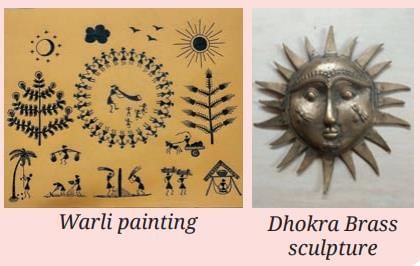
Why Do We Launch Artificial Satellites in Space?
Natural vs Artificial Satellites
- The Moon is Earth’s natural satellite, revolving around our planet.
- Artificial satellites are man-made objects placed in orbit around Earth by various countries.
Artificial Satellites: Purpose and Functions
- Appearance: Artificial satellites look like tiny bright spots moving rapidly across the night sky.
- Orbit: Most orbit at about 800 km above Earth’s surface, completing one orbit in roughly 100 minutes.
Key Uses:
- Communication (TV, phones, internet)
- Navigation (GPS, map services)
- Weather monitoring
- Disaster management (detecting floods, cyclones, etc.)
- Scientific research (studying space, environment, and more)
Satellites and Missions by ISRO (Indian Space Research Organisation)
- Cartosat Series: High-quality imaging satellites for mapping, city planning, and disaster response.
Example platform: Bhuvan uses Cartosat images to analyze soil, land use, vegetation, and terrain.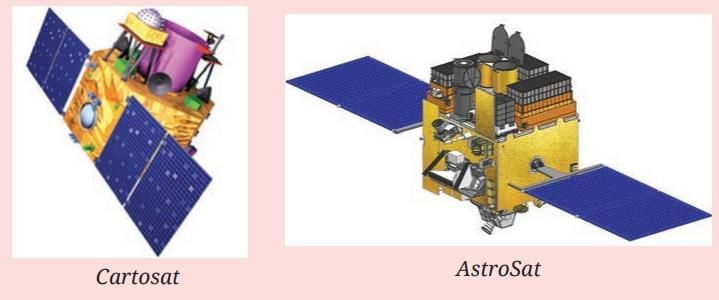
- AstroSat:
Observatory satellite for studying stars and celestial objects. - Chandrayaan 1, 2, 3:
Moon missions. - Aditya L1:
Satellite for studying the Sun. - Mangalyaan:
Mars Orbiter Mission. - Student Satellites:
ISRO encourages students to build and launch small satellites, such as: AzaadiSat, InspireSat-1, and Jugnu.
Observing Artificial Satellites
How to Spot:
Look for a small, bright, continuously moving dot in the sky, typically before sunrise or after sunset.
- Can be seen without a telescope.
- Satellite-tracking mobile apps or websites help identify visible satellites.
Space Debris (Space Junk)
- When artificial satellites and rocket parts become old and stop working, they turn into space debris.
- Risks: Collisions with functional satellites, cluttering orbits.
Disposal:
- Small debris usually burns up in the atmosphere.
- Larger fragments can fall and crash to Earth.
- Countries collaborate on solutions to minimize and remove space debris.
Key Figures in Indian Space Program
Vikram Sarabhai:
Pioneer of India’s space program, known as the "Father of the Indian Space programme".
- The Vikram Sarabhai Space Centre (VSSC) in Thiruvananthapuram is named in his honor.
- VSSC focuses on rocket and launch vehicle technology.
Key Points to Remember
- Phases of the Moon: The changing shapes of the illuminated part of the Moon observed from day to day, such as new Moon, crescent, and full Moon.
- Cause of Moon Phases: The phases occur because we see varying portions of the Moon's illuminated side as it orbits around the Earth.
- Cycle of Moon Phases: A complete sequence of the Moon's phases, which takes about a month to finish.
- Calendars: Systems created based on various natural cycles observed in nature, used to track time.
- Lunar Calendar: A calendar that follows the cycle of the Moon's phases.
- Solar Calendar: A calendar that follows the cycle of seasons, determined by the Earth's position in its orbit around the Sun.
- Luni-solar Calendar: A calendar that adapts to both the Moon's cycles and the seasonal cycles related to the Earth's orbit.
- Artificial Satellites: Human-made objects launched from Earth into space, which provide valuable information for human well-being and studies in space science.
FAQs on Keeping Time with the Skies Chapter Notes - Chapter Notes For Class 8
| 1. How does the Moon's position affect its appearance in the night sky? |  |
| 2. What are the different phases of the Moon, and how long does each phase last? |  |
| 3. Why do we see different shapes of the Moon throughout the month? |  |
| 4. How do calendars incorporate the phases of the Moon? |  |
| 5. What historical significance do the Moon phases hold in various cultures? |  |
















